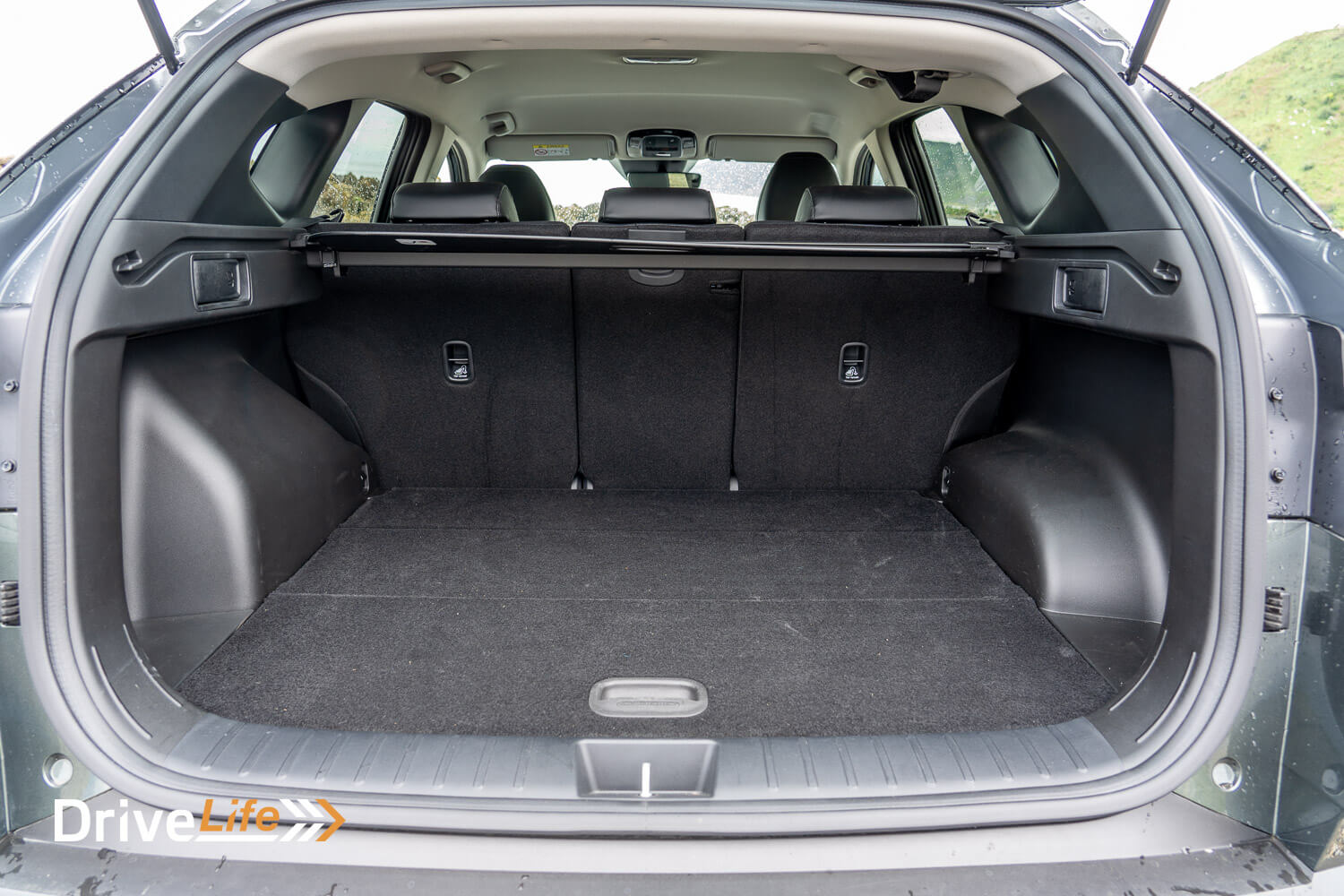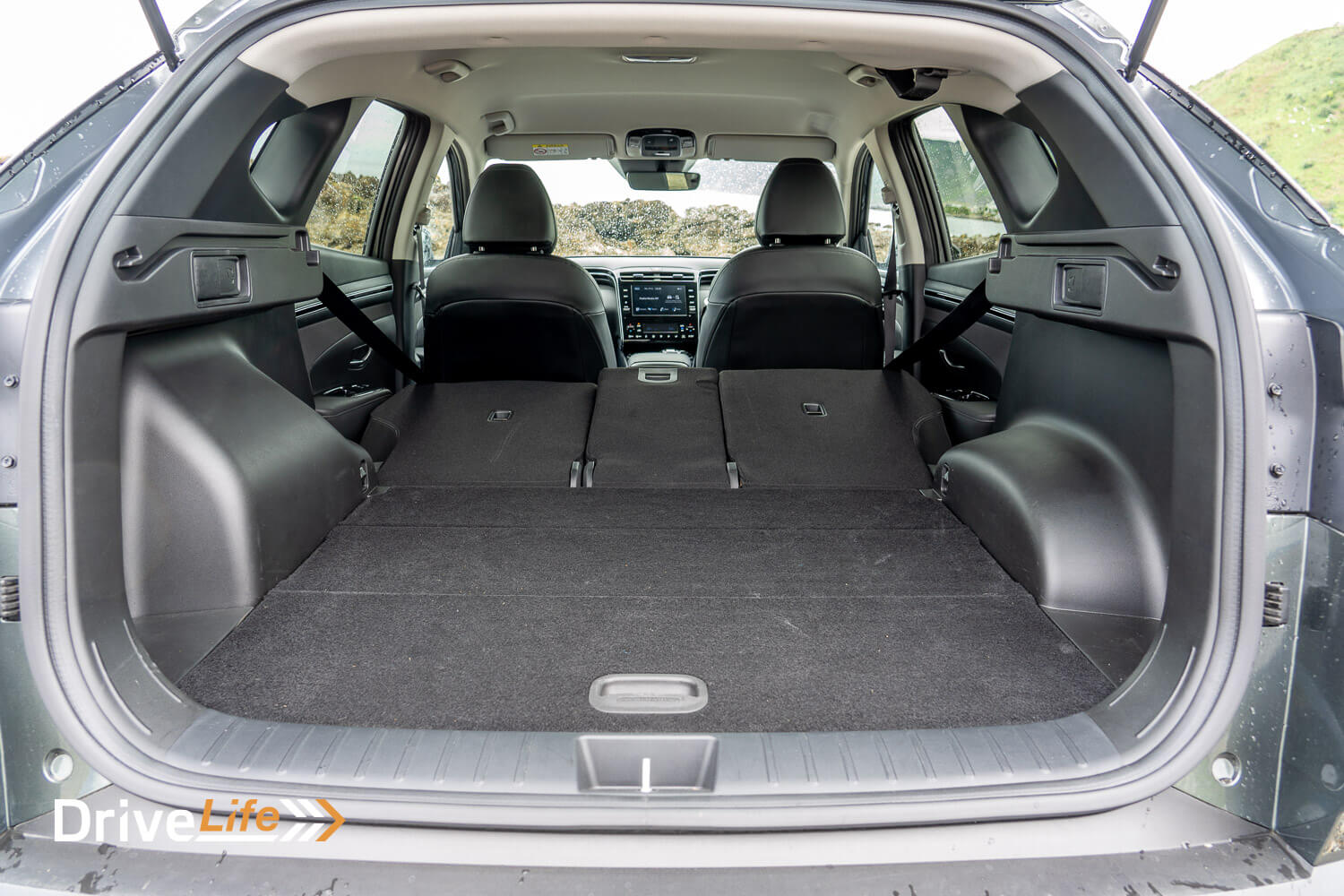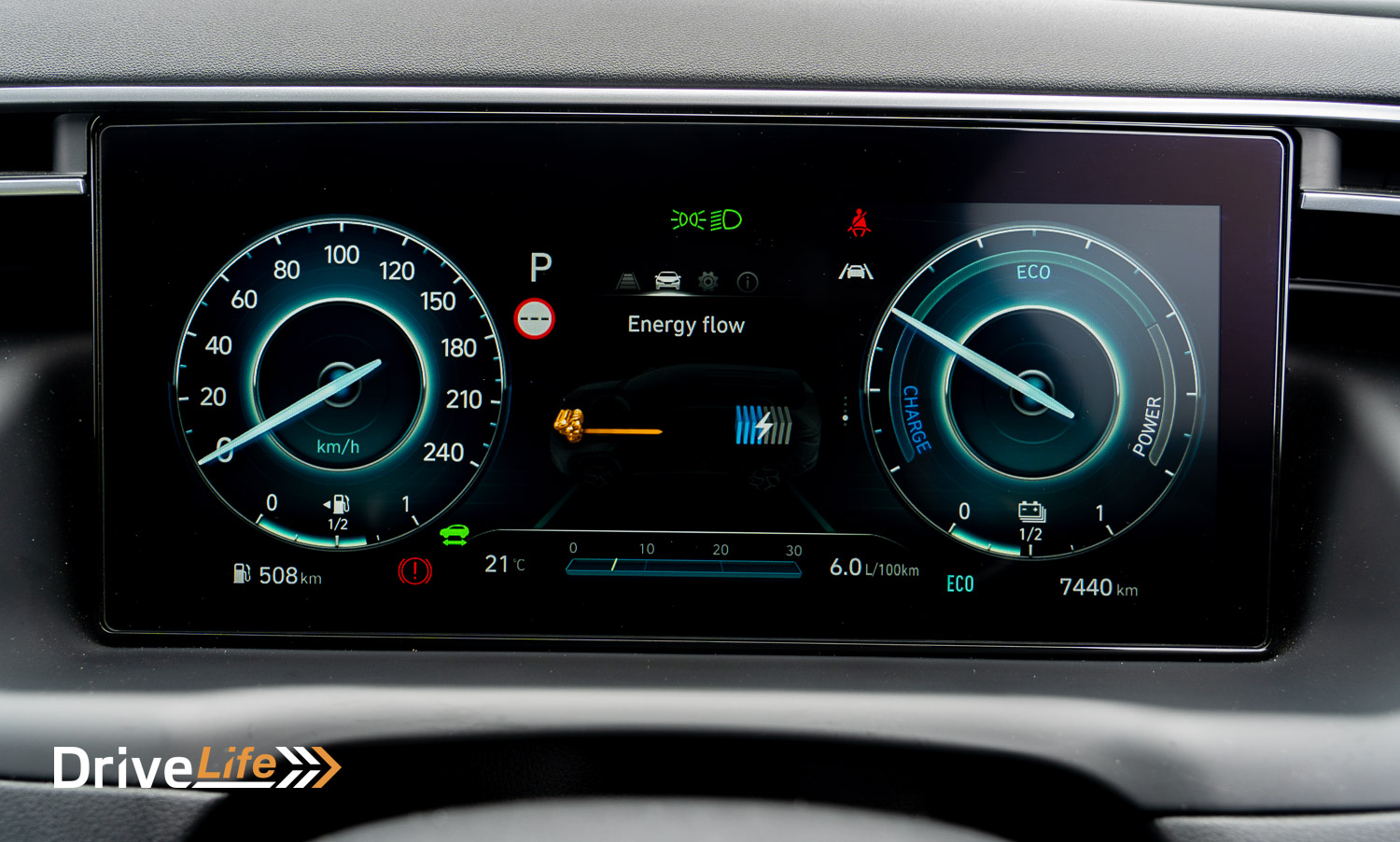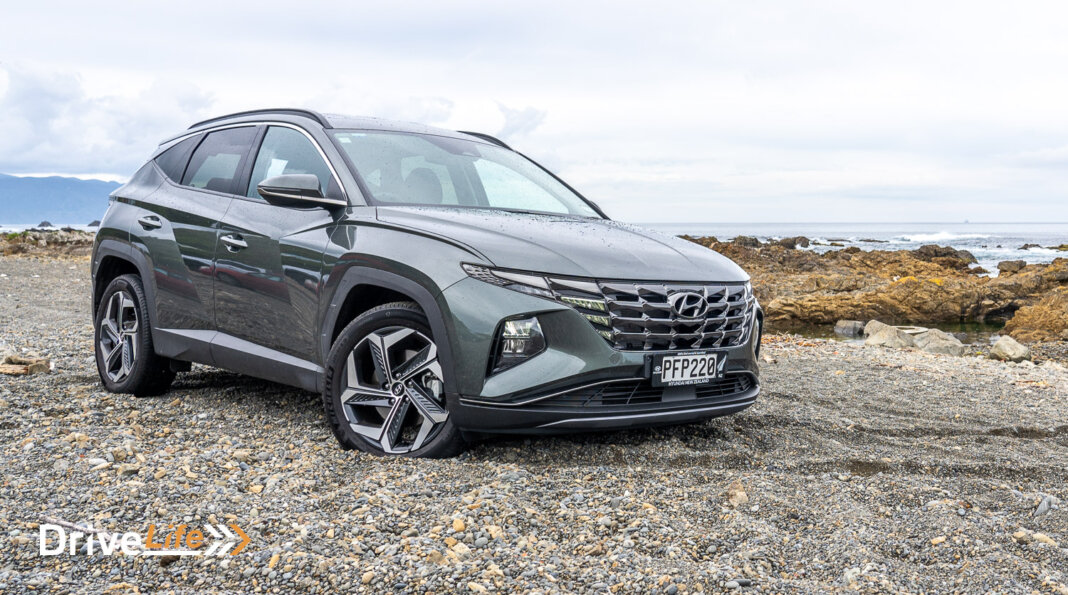After reviewing the Hyundai Kona Hybrid Elite recently, Hyundai sent us the next size up, the Tucson Hybrid Elite. We enjoyed the Kona Hybrid; it makes a breeze of hybrid driving and is one of those models that could sway you from moving up to the next level, with a plug-in hybrid.
But what about the Tucson Hybrid Elite? Will it be just as easy to drive as the Kona Hybrid, and as easy to live with on a daily basis? We drove the 2022 Hyundai Tucson Hybrid Elite for a week and 600km to find out.

What We Like and Dislike About The 2022 Hyundai Tucson Hybrid Elite
| What we like | What we don’t like |
| Fuel economy Ease of hybrid use Build quality Design AWD grip Overall equipment levels Modern styling Boot size Performance Steering wheel controls | Some expected features missing Bluetooth connection issues $10K premium over non-hybrid Engine noise up steep hills Visibility |
What’s In The 2022 Hyundai Tucson Hybrid Range?
Hyundai has managed to get 6 models available in the hybrid range alone, in a mix of straight hybrid, plug-in hybrid and then either two-wheel-drive (2WD) or all-wheel-drive (AWD).
For our test car, the Elite AWD at $72,990, there’s a $10,000 premium to pay over the non-hybrid model. You lose the electric passenger’s seat when you go from the Elite petrol-only model to the hybrid.
| Powertrain | Variant | Retail Price |
| 1.6 T-GDI Hybrid 2WD | Entry | $61,990 |
| 1.6 T-GDI Hybrid 2WD | Elite | $66,990 |
| 1.6 T-GDI Hybrid AWD | Entry | $67,990 |
| 1.6 T-GDI Hybrid AWD | Elite | $72,990 |
| 1.6 T-GDI Plug-in Hybrid AWD | Entry | $83,990 |
| 1.6 T-GDI Plug-in Hybrid AWD | Elite | $89,990 |
NB: Prices are Recommended Retail Price (RRP) and exclude ORC.
The powertrain on all hybrids is the same, with only two-wheel-drive and four-wheel-drive being the mechanical differences, and levels of trim go up between the Entry and Elite models.
All are powered by a 1.6-litre, turbocharged, 4-cylinder petrol engine that manages 132kW of power and 265Nm of torque. The combined power output when you add in the hybrid system is 169kW and the torque goes up to 350Nm. The electric mode itself puts out 44kW of power and 264Nm of torque. The lithium-ion battery pack is pretty tiny, at 1.49kWh.
The plug-in hybrid (PHEV) Tucson has a larger 13.8kWh battery pack giving a range of up to 57km. It increases the maximum combined power of the vehicle to 195kW, while torque remains the same at 350Nm.
All Tucsons use a 6-speed automatic transmission.

2022 Hyundai Tucson Hybrid Standard Equipment Highlights
Equipment levels are reasonable, with the base Entry models having:
- Heated mirrors
- LED DRLs
- Rear spoiler with high-mounted LED stop light
- Leather steering wheel
- 8” touchscreen
- Apple CarPlay and Android Auto
- Dual-zone AC
- ABS braking with Electronic Brake-Force Distribution (EBD)
- Brake Assist System (BAS)
- Electronic Stability Control (ESC)
- Traction Control System (TCS)
- Vehicle Stability Management (VSM)
- Blind-spot Collision Avoidance assist (BCA)
- Rear Cross-traffic Collision Avoidance (RCCA)
- Forward Collision Avoidance (FCA)
- Forward Collision Avoidance-Junction assist (FCA-JX)
- Lane Keeping Assist (LKA)
- Lane Following Assist (LFA)
- High Beam Assist (HBA)
- Smart Cruise Control (SCC) with stop & go
- Driver Attention Warning (DAW)
- Safety Exit Assist (SEA)
- Rear Occupant Alert (ROA)
- 7 Airbags (Dual Front, Side, Curtain & Front Centre Airbag)
- Front seatbelt pretensioners and load limiters
- 3-point tether child seat anchor points
- 2 x ISOFIX child seat anchor points
- Height adjustable seat belts (front)
- 3-point lap diagonal (ELR) seatbelts
- Child safety rear door locks
- Automatic dusk sensing headlights
- Rain sensing wiper system
- Reversing camera
- Tyre pressure monitoring system
- Electric park brake
Moving up to the Elite model adds:
- Auto-dipping rearview mirror
- Rear Park Assist
- LED headlights
- LED taillights
- Privacy glass (rear doors)
- Roof rails
- Leather interior
- 8-way electric driver’s seat
- Heated front and rear seats
- Wirelss phone charging
- Keyless entry and start
- 10.25” colour digital dashboard
There are nine colours to choose from for your Tucson;
- Engine Red
- Phantom Black
- Dark NKnight
- Amazon Grey
- Silky Bronze
- Sunset Red
- Polar White
- Shimmering Silver
- Teal
For a full list of specs and options available for the 2022 Hyundai Tucson Hybrid Elite head on over to the Hyundai New Zealand website
How Does The 2022 Hyundai Tucson Hybrid Elite AWD Compare To Its Competition?
All prices below exclude the refund or additional cost of the New Zealand Clean Car Programme.
| Make/ Model | Engine | Power/ Torque kW/Nm | Seats | Fuel L/100km | Towing Capacity | Boot Space, litres | Price (excl CCP) |
| Lexus UX250h (AWD) | 2.0-litre, 4-cylinder petrol/hybrid | 135/188 | 5 | 5.2 | NA | 220 | $77,500 |
| Hyundai Tucson Hybrid Elite AWD | 1.6-litre, turbocharged 4-cylinder petrol/hybrid | 169/350 | 5 | 4.9 | 750 | 503 | $72,990 |
| Toyota RAV4 Limited Hybrid (AWD) | 2.5-litre, 4-cylinder petrol/hybrid | 163/221 | 5 | 5.3 | 750 | 580 | $58,290 |
| Kia Niro HEV GT Line (FWD) | 1.6-litre, turbocharged 4-cylinder petrol/hybrid | 104/265 | 5 | 4.4 | 600 | 451 | $57,990 |
| Ford Escape ST-Line (AWD) | 2.5-litre, 4-cylinder petrol/hybrid | 140/NA | 5 | 5.6 | 750 | 556 | $57,990 |
| Subaru Forester Premium Hybrid (AWD) | 2.0-litre, 4-cylinder petrol/hybrid | 110/262 | 5 | 6.7 | 650 | 345 | $56,990 |
| Haval H6 Ultra Hybrid (FWD) | 1.5-litre, turbocharged 4-cylinder petrol/hybrid | 179/530 | 5 | 5.2 | 750 | NA | $48,490 |

First Impressions Of The 2022 Hyundai Tucson Hybrid Elite AWD
Naturally, our test car was finished in Amazon Grey. I was told “it’s a different sort of grey”, but honestly, it’s not. I’ve seen some Tucsons in stunning colours like Teal and Sunset Red, so I know the potential is there. Still, the car is a good looker. It’s certainly still current in design thinking, although it will be interesting to see if the shape dates quickly.
I love the full-width light bar on the rear, and at the front, those LED headlights look excellent. There’s no mistaking a 2022 Tucson from the front or rear. Hyundai has done well to give the car an identity and make it good-looking at the same time.

What’s The Interior Like In The 2022 Hyundai Tucson Hybrid Elite AWD?
The interior is pretty standard Hyundai, so that does mean that there’s quite a bit of hard, black plastic dotted about the cabin. In other areas of the interior, the quality really shows through but this is one area where Hyundai still hasn’t listened. Quite a few of the touchpoints don’t feel nice.

There is lots of piano black inside; the dash (all around the touch screen), the console and the doors all have a piano black finish. The doors are the worst, as this finish is all around the power window controls, meaning it’s fingerprint city.
Up on the high centre console are the push buttons for changing gears. I think most Hyundai models have gone this way now, and it doesn’t take long to get used to using them. I had a few moments when doing three-point turns where I didn’t hit the button hard enough or pushed the wrong one, but overall they do the job well and allow for more centre console real estate.

While the driver gets a 6-way electric seat, the front seat passenger makes do with manual adjustment in the hybrid model. The seats are very comfortable – front or rear – with no aches of any sort, even after a long time behind the wheel. It was nice to see both front and rear seats are heated, with three stages to choose from.

Up front, there are two USB-A ports, as well as a 12-volt socket for your dash cam, and a Qi wireless charge pad. The wireless charge pad is angled towards the front of the car to reduce the temptation for the driver to look at their phone, and we’re seeing a lot of this on all sorts of brands recently.

Rear-seat passengers also get 2 USB-A ports in the centre console, with legroom that’s average for the class. Headroom is fairly generous, and there’s certainly plenty of width. It would be a comfy car for a Wellington-Auckland run.
The boot – keep in mind it’s not an electric tailgate – is large in size at 503 litres and has some decent under-floor storage.




What’s The 2022 Hyundai Tucson Hybrid Elite AWD Like To Drive?
On picking up our test car with a full tank of petrol, the range showed as 775km. Ambitious stuff. Out from the dealership, the performance potential is immediately noticeable. It’s extremely peppy, just bordering on a bit jerky. It took me a bit to get used to the response from the accelerator, and then to drive the car smoothly.
Part of the reason for this off-the-mark performance is the engine. Sure, it’s only 1.6 litres in size but the Tucson Hybrid gets the same powertrain as the 300kg heavier Santa Fe Hybrid. This really endows the car with spirited acceleration.

The Tucson Hybrid has two drive modes; the default on starting the car is Eco, and then you get Sport mode as an option. Other than for something like an Audi RSQ7, we’ve always wondered why manufacturers add a Sport mode to an SUV. The Hybrid Tucson has this, and sure, it makes the car quicker off the line, but is that what you buy a hybrid SUV for? Ok, the gauges turn a cool red colour in Sport mode, but the transmission holds the gears for far too long.
There’s so much performance available in Eco mode, I tried out Sport mode two times and then ignored it. Even in Eco mode, for a 1.6-litre motor in a mid-sized SUV, the Tucson can really honk along. You might think that off-the-mark performance is going to be lacking, but this is where the car actually shines – it can leave others in its wake at the traffic lights. That’s not to say performance overall isn’t good – it’s very good. Midrange power with hybrid assist is great for overtaking on the open road, ditto changing lanes to pass on the motorway. Yes, it’s a hybrid, but for that engine and that size electric motor in this size of SUV the performance is still surprising.

As well as the two drive modes, you get to pick from some terrain modes when needed; Snow, mud, or sand. Handy to have on the farm, at the ski field, or on your lifestyle block.
That engine, while surprisingly peppy, can get a bit vocal up some of Wellington’s steeper hills. On the whole, it’s there but muted, and on a flat section of motorway it is almost silent, but a direct-injection petrol engine is a little noisier at the best of times, and steep hills are not its friend.

It might be a hybrid but as part of that “just drive it” feeling, you don’t get any control over brake regeneration. The Tucson Hybrid Elite does have steering wheel paddles, but those are for controlling the gearbox. In fact, even if the car is running in EV mode, pulling on either paddle will see the engine start-up.
The Elite model has an 8” centre screen with Hyundai’s standard user interface, so it works well overall, with a slight bit of lag. Anyone who’s been in a Hyundai recently will feel right at home with the infotainment system. There’s no SatNav on this $79,000 SUV which was a bit surprising, but you do have Apple CarPlay and Android Auto available via a USB cable.




Since there’s no 360-degree camera, that also means this car misses out on Hyundai’s excellent blind spot camera system, which would have made daily driving the Tucson Hybrid Elite just that little bit safer. But still, the ease of Daily Driving this car is hard to beat, perhaps only by the Hyundai Kona Hybrid we recently reviewed. Like the Kona Hybrid, the Tucson has no user controls for adjusting anything to do with the hybrid system – you just get in and drive. I found this to be an excellent and simple way to drive when testing out the Kona Hybrid, and it was no different for the Tucson Hybrid.
Other than a Drive Mode button and steering wheel paddles, the driver doesn’t need to know or do anything. I expect this simplicity will appeal to a lot of buyers who want a hybrid but are confused about how they should drive one. I’ve always leaned towards having some control over how the hybrid system works, but Tucson does it so well that I am a convert for their system. Accelerating away, even gently, will see the petrol engine start most of the time, but these are all expected behaviours;
| Start/Low speed | When starting or driving at low speed, the electricity stored in the battery powers the electric motor to accelerate. |
| Acceleration/ Uphill | During heavy acceleration or driving uphill, the electric motor and petrol engine work in parallel to maximise acceleration and minimise fuel consumption. |
| Constant speed | At constant speeds, power is provided by either the petrol engine or the electric motor, whichever is the most energy-efficient in that situation. |
| Deceleration/ Downhill | The regenerative braking system charges the battery by using the electric motor to slow the car. When decelerating or driving downhill, the energy generated is stored in the battery. |
| Regenerative braking | When decelerating (e.g. through braking or when driving downhill) the electric motor operates as a generator and regenerates kinetic energy into electric energy, which is then stored in the battery. |
The above table shows how the hybrid system should play out, and it’s a nice feeling that even when doing 100km/h on the motorway, occasionally the car will still go into EV mode, which is shown on the dashboard.

Wind noise in the car is negligible, even at 100km/h on the motorway. At that speed the engine is almost silent too, meaning stress-free long-distance driving in the Tucson Hybrid.
Since we’re reviewing the all-wheel-drive (AWD) version of the Tucson, one of the driver’s displays will show what wheels are driving at any time, if that’s your thing. The AWD system does give surety in all driving conditions; one day (we had a LOT of rain during our test period), I drove through a long, deep puddle on the road and the Tucson did nothing unusual, no dramas, and just went through that puddle as if the road were dry. As the driver, this gave me confidence that the AWD system was working well.

While the Tucson is a family SUV, the chassis can still hold its own on some twisty roads, with superb grip in dry conditions, again giving the driver confidence in the car. In saying that, one particularly gnarly corner in the wet saw the front start to slide earlier than expected. I put some of this down to the steering; it’s hard to know what the front end is doing at the best of times, and those Michelin Primacy tyres seem to let go fairly early when wet.
Like the other Tucson models, there is no cowl over the dashboard, which can lead to bad reflections in direct sunlight, although Rob didn’t experience this last year when he reviewed the diesel model. I’m not seeing any real benefit of not having a cowl other than it looks pretty cool. You get to pick from a large range of options for the trip computer, and it’s a fully digital dash so the ‘analogue” speedo and rev counter are digitally designed, but still very easy to read at a glance. It’s surprising the car has a 240km/h speedo; I’m not sure I’d want the car up anywhere near that speed.



The leather-wrapped steering wheel feels superb, as against those hard, black plastic panels we talked about already. The controls are perfect too; the same as other Hyundai and so simple to use without needing to look at them. Long may they stay without change.
Like other cars we’ve had with the Michelin Primacy tyres, they can be noisy on coarse chip seal. Most tyres struggle with our lovely coarse chip seal but the Primacy does seem to be affected more greatly by it. They’re a good tyre in most other respects, however.
The ride on the Tucson is generally excellent. That extra weight of the hybrid system helps to pound out most bumps, but regardless it rides very well for what it is. Smaller bumps like speed bumps will see it a little unsettled after going over one, but nothing dramatic and almost not worth mentioning. The quality of the ride helps in the ease of daily driving this car.

Without those side mirror cameras, you are going to be relying on the blind spot monitoring system on the mirror lenses, as the Tucson has huge B and C pillars. Rear three-quarter views are pretty much non-existent. A sexy rear end means there is a compromise somewhere, and that visibility out from the inside is the price to pay.
The steering wheel also carries a button for Lane Follow Assist, and it’s a good system, although it does tend to favour the right side of the lane sometimes. It’s a nice peace-of-mind option if you want to reduce some of the concentration from your driving so you can focus on other parts of the drive.

The steering wheel is haptic, so if there is an alert of some sort, then the wheel will shake slightly to tell the driver. It’s a simple yet effective system, and I wish more cars had it.
Adaptive cruise control helps reduce fatigue too and helps the driver of the Tucson Hybrid avoid a nose-to-tail collision. It’s a stop-go system in Tucson, so will bring the car to a complete stop, and if you don’t have to wait too long, will automatically move off again. If you are sitting for a while, a tap for the gas pedal or the cruise control button will see the car move off.

I’m not sure why, but I’ve had a run of cars with Bluetooth issues recently, and the Tucson was guilty of this too. Some days it just wouldn’t connect, or on better days I’d have to go into the settings for the phone and force the car to connect, and then it would all work. We went through a period of 3 or 4 years where Bluetooth worked well on all cars, but we seem to be slipping back again to the dark old days.
Over a week with the 2022 Hyundai Tucson Hybrid, I managed to cover 600km of driving under different conditions and roads, and the car returned 6.1L/100km. That’s an excellent result for this size of car and compares well to the 8.5 I got from the Mazda CX-5 Takami, and the 5.1L/100km I got from the Kona Hybrid.
So, how does the 2022 Tucson Hybrid Elite AWD compare to the 2022 Tucson Elite AWD? There’s a $13,000 price difference between the two, and while Hyundai suggests fuel consumption of 7.7l/100km for the non-hybrid, they suggest the hybrid should do 4.9l/100km, a saving of 2.8l/100km. At an average price of say $2.50/litre, that means a saving of $7/100km. This does mean that to get your $13K premium back, you’d need to travel around 185,000km to break even (depending on future fuel costs).

2022 Hyundai Tucson Hybrid Elite AWD – Specifications
| Vehicle Type | Medium AWD hybrid SUV |
| Starting Price | $72,990 |
| Price as Tested | $72,990 |
| Engine | 1.6-litre, turbocharged, 4-cylinder petrol with hybrid assistance |
| Power, Torque kW/Nm | 169/350 |
| Transmission | 6-speed automatic |
| Spare Wheel | Pump only |
| Kerb Weight, Kg | 1,685 |
| Length x Width x Height mm | 4500x1865x1650 |
| Boot Space / Cargo Capacity, Litres (seats up/seats down) | 503/NA |
| Fuel tank capacity, litres | 52 |
| Fuel Economy, L/100km | Advertised Spec – Combined – 4.9 Real-World Test – Combined – 6.1 Low Usage: 0-6 / Medium Usage 6-12 / High Usage 12+ |
| Towing Capacity Kg, unbraked/braked | 750/1,650 |
| Turning circle metres | 11.0 Small: 6-10m / Medium 10-12m / Large 12m+ |
| Warranty | 3 Year 100,000km Warranty 8-year 160,000km High Voltage Battery Warranty 8 Year Roadside Assistance package 10 Year Anti Corrosion Warranty |
| Safety information | ANCAP Rating – 5 stars – Link Rightcar.govt.nz – 5 Stars – PFP220 |
Have you enjoyed this review? Be sure to join our monthly email newsletter list so you don’t miss a single car review!








